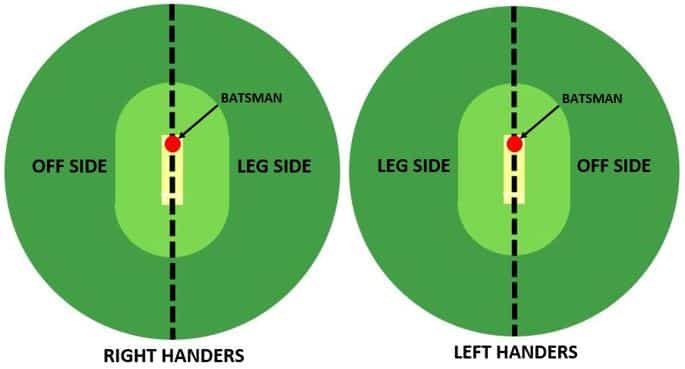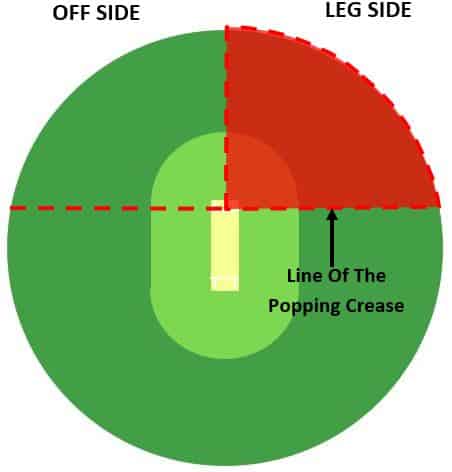‘Leg side’ and ‘off side’ are another two terms that can be confusing if you’re a newcomer to cricket. You will hear both terms mentioned many times throughout the course of a game, and if you’re a player, you’ll also hear them spoken about during your training sessions! This is why you need to know what they are!

A cricket field can theoretically be split right down the middle into two halves. One of these halves is labelled the off side, and the other is labelled the leg side. As for which side is which, this depends entirely on whether the batsman at the crease is right or left handed! The best way to remember it is that the off side is always the side of the field that the batsman is facing when they are in their batting stance. So, from the perspective of the bowler, a right handed batsman will be facing the left side of the cricket field, making this the off side. The side of the field that a right handed batsman has their back to, is the leg side. The opposite is true for left handed batsmen! Again, from a bowlers perspective a left handed batsman will be facing the right side of the field, making this the off side. Therefore, the left side of the field becomes the leg side in this case.
What Is The ‘On Side’?
The ‘on side’ in cricket is exactly the same thing as the leg side. These terms can be used interchangeably! Cricket is funny like that, there are so many words that can be used to describe the exact same thing. I’d say the term leg side is the most common, however there are a fair few cricket commentators that use on side in its place!
How Many Fielders Are Allowed On The Leg Side Of The Field?
Cricket has many rules regarding where fielders are allowed to stand during a match. Some of these rules specifically relate to how many fielders a captain is allowed to position on the leg side of the batsman. However, these rules vary depending on the type of cricket that is being played. Let’s examine these in closer detail…
Test Matches
The rules regarding leg side fielders in test matches are a bit less restrictive than limited overs cricket. In tests, a fielding team is not permitted to have more than two fielders behind square on the leg side. More specifically, this means that when the ball leaves the bowlers hand, no more than two fielders are allowed behind the line of the popping crease on the leg side. This does not include the wicket keeper!
A good thing to remember is that even if a fielder has one foot behind the line of the popping crease, he is considered to be in that zone! A fielder must remove his whole body from that area if they do not want to be classed as being behind square on the leg side. I have used the diagram below to illustrate the area that I am talking about!

If a team has more than two people behind square on the leg side as the ball is bowled, the umpire will call and signal a no ball.
Limited Overs Cricket (ODI’s and T20I’s)
The same rule that exists in test matches is also applied here! No fielding team is allowed to have more than two fielders behind square on the leg side (excluding the wicket keeper) when the ball leaves the bowlers hand.
Limited overs matches also add another rule to the mix. In ODI’s and T20I’s no fielding side is allowed to have more than 5 fielders on the leg side when the ball is bowled. This excludes the wicket keeper and the bowler. If we take away the wicket keeper and the bowler, this leaves a total of 9 fielders that will be patrolling the ground. And since a maximum of 5 of them can be present on the leg side, the other 4 must remove their entire bodies from this area if they want to avoid the umpire calling and signalling a no ball.
Which Cricket Shots Are Played Through The Off Side?
Certain cricket shots can only be played on one side of the field, and with that in mind I’m going to list the most popular off side shots here! Let’s take a look at them:
- The Cover Drive – The cover drive is one of the most famous cricket shots, and probably the most satisfying one to watch! It can be played on the front or the back foot, and it is hit through the cover region, which is halfway between straight and square of the wicket on the off side.
- The Square Drive – This is a shot that is very similar to the cover drive, although it is only really played on the front foot. This shot is usually played to relatively wide deliveries and is hit just in front of square on the off side.
- Reverse Sweep – The reverse sweep is usually played when facing spin bowlers and involves the batsman taking a stride down the pitch and sinking down in their stance. The batsman must then extend the bat out in front of their body and roll the hands over so that the bat face points towards the off side before using it to deflect the ball. This shot can be hit anywhere behind square on the off side.
- Square Cut – Deliveries that are short and wide are prime candidates to be square cut to the boundary. This is primarily a back foot shot where the batsman will get up on his/her toes before extending their hands and striking the ball square of the wicket with a nice flourish.
- The Uppercut – This is another back foot shot that is played to deliveries that are quite short and wide of the off stump. For this shot, the batsman must wait for the delivery to reach its highest point before using the bat to glance the ball over the slip region.
This is just an introduction to the types of shots you’ll see played through the off side. If you want a much more detailed explanation of every type of cricket shot, then check out one of the most detailed posts I’ve ever written by clicking here! It includes all the different cricket shots you’re likely to see, and I’ve also given explanations on when and how to play each shot! In my opinion it’s a good post to start with for a lot of people who are new to the game!
Which Cricket Shots Are Played Through The Leg Side?
Here are some leg side shots you should be aware of if you want to set yourself on the path to becoming a true 360-degree batsman!
- The On Drive – This shot can be played on the front or the back foot, and it is played to relatively straight deliveries that are on the line of the stumps or the batsman’s body. It is hit slightly to the leg side of the bowler, down towards the ‘long on’ fielding position.
- The Sweep – The sweep is primarily played when batting against spin bowlers. For this shot the batsman will take a decent stride down the wicket, and sink down into their stance. The bat is then extended in front of the front knee and the face of the bat is used to deflect the ball behind square on the leg side.
- Leg Glance – This is another shot that can be played on the front or back foot. The deliveries that this shot is played to will usually be aimed at the batsman’s body. The ball is ‘glanced’ away from the batsman’s legs – hence the name! This shot can be hit pretty much anywhere on the leg side of the field, but the main areas are usually square and behind square of the wicket.
- Pull Shot – This is a back foot shot that is played to deliveries between waist and shoulder height. For this shot, the batsman will rock onto the back foot and strike the ball with a horizontal bat face into the leg side. It can also be played pretty much anywhere on the leg side but the primary areas are square and behind square.
- Hook Shot – This is very similar to the pull shot except it is played to deliveries that are a little shorter. Anything above shoulder height is a good candidate for the pull shot! Again, the bat is brought through horizontally and the ball is usually hit either square or behind square on the leg side.
I haven’t covered all of the cricket shots here, these are just the main ones. To see the rest of the shots and to find out how to play them all you’ll have to check out the article I linked to in the last section! Here is the link if you missed it!
Feel free to leave me a comment below if you’ve got any other questions relating to this that you’d like me to answer!
